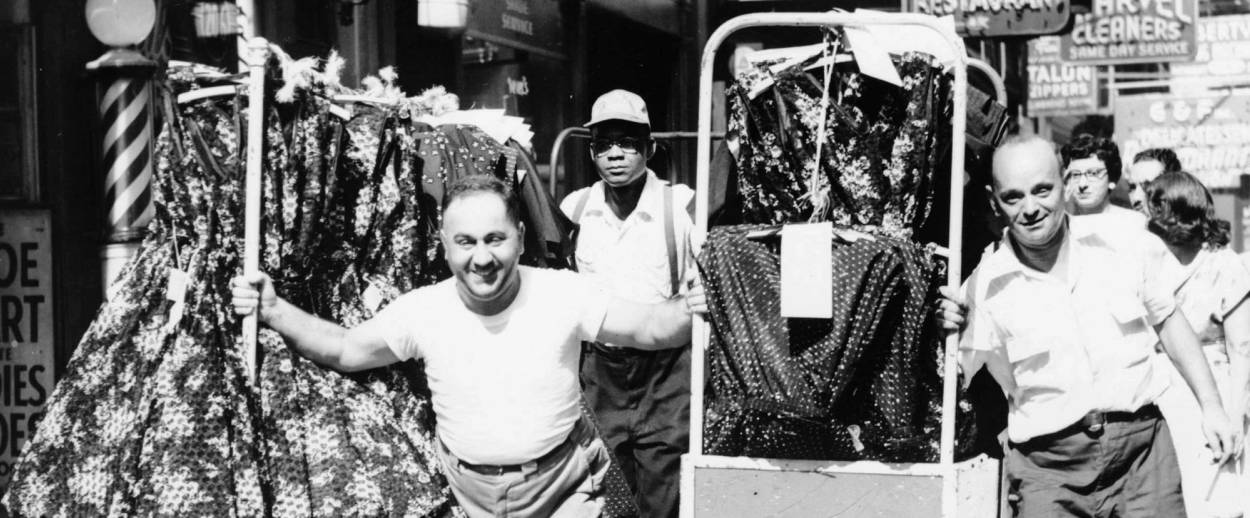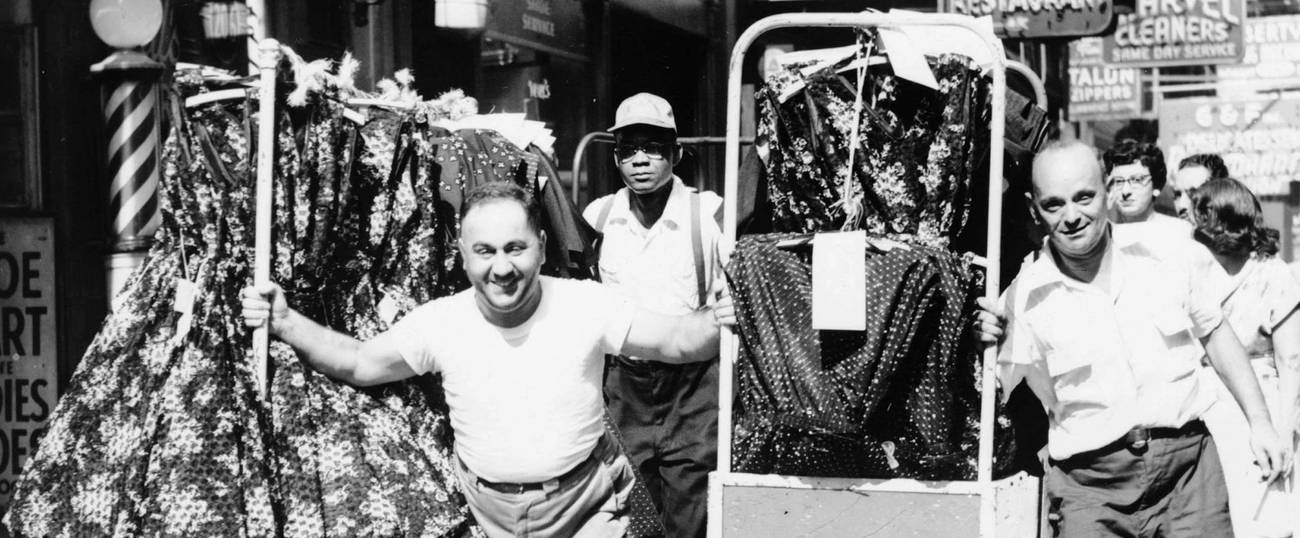The Garment District’s Bustling Past and Uncertain Future
Mayor De Blasio may be killing Manhattan’s storied neighborhood, once dense with high-rise factories, its sidewalks crowded with garmentos and push boys




Recently I found myself tootling around the streets that constitute New York’s storied Garment District, a six-block area between West 35th Street and West 41st Street, Broadway and Ninth Avenue. Actually, “tootling around” isn’t quite the right expression. No street signs prohibit a leisurely stroll up one built-up block and down another, but there might as well be. Everyone and everything moves fast; promenading is simply not a possibility. Besides, at street level, there’s not much to take in. Scaffolding blocks the eye at nearly every turn, and if that’s not enough to discourage close scrutiny, the honky-tonk, tawdry streetscape does the rest.
The only way to appreciate the Garment District is to look up, craning your neck this way and that until it starts to hurt. It’s at that point, when you see the building line meet the sky, that the neighborhood’s distinctive architecture—its dense cluster of skyscraper factories and concentrated use of setbacks—comes fully into view.
A product of the 1920s, when Jewish garment-manufacturers-turned-builders vied with one another to create the most up-to-date, capacious factories for their workers as well as glamorous, enticing showrooms for their goods, the Garment District, explains Columbia University architectural historian Andrew Dolkart, housed the “largest concentration of high-rise factory buildings in the world.” And if that’s not enough to turn your head, consider this: “Few areas,” Dolkart noted, “are more integral to the 20th-century history and legend of the city.”
But change is the preferred coin of the realm in New York and other American cities on the go. If the powers-that-be have their way, the much-vaunted garment center might soon become a thing of the past, its manufacturers, designers, suppliers, and workers relocated to new industrial spaces in other parts of the city.
Bruited about for a number of years, this plan received a new lease on life a few months ago when New York City’s mayor, Bill de Blasio, expressed support for a Made in New York “manufacturing campus” in Sunset Park, Brooklyn, and, concomitantly, for the rezoning of the Garment District for commercial and residential use.
Supporters of the mayor’s proposal claim it will lead to the revitalization of the Midtown district as office workers take the place of a steadily dwindling number of factory hands. The real-estate industry has also warmed to the idea of “freeing up” the area, looking forward to generating even higher rentals. Critics, in turn, argue that the mayor’s plan will undermine the garment industry’s “complex ecosystem,” tarnishing the city’s reputation as a fashion mecca.
Whatever the outcome, something—a certain sensibility, say, or a characteristically New York form of energy—is bound to give. Vestiges of the neighborhood’s vibrant past are already hard to come by. When, in the course of my peregrinations, I ventured into once-celebrated buildings in an attempt to strike up a conversation with the lobby attendant about matters historical, I was met with stares of either incomprehension or incredulity: “Huh?”
Hardly a trace remains of the once-imposing lobbies that graced these skyscraper factories, their lofty architectural aspirations now hidden under a drop ceiling or muted by bands of fluorescent lighting. The handwritten door signs that proclaimed with a flourish the existence of La Grand Costume Co., The Coat House of America, and Garfinkel, Rosenblatt & Co., whose coats, wraps, and suits promised to “add grace, charm, and youthfulness to stout women,” are no more, either.
It won’t take long before the garment center’s characteristic hustle and bustle follows suit, succumbing to a new and more subdued urban rhythm. Well into the 1980s, the streets were filled with movement as well as with stuff: Bolts of fabric swathed in brown paper waited to be unloaded from idling trucks; finished garments, wrapped in plastic, clung to one another on the metal racks of hand trucks, whose “push boys” adroitly navigated them from one destination to another without colliding into passersby.
The streets of the garment center were filled with people, too, especially at lunchtime. As if released from a long day at school, garment workers and their bosses congregated outside and in the many affordable eateries that dotted the neighborhood. The city’s newspapers took note of the congestion and of the accompanying noise. Some branded the daily ritual a “blight”; others, a spectacle. Either way, the sea of employees and employers was hard to miss.
Before long, the garment center at midday even became something of an urban sensation. Guidebooks made sure that visitors to New York added it to their itinerary of must-see sights. “In these crowded streets at noon, thousands of workers, East and Southern European by origin, Italians and Jews mostly, descend for food, fresh air, and sun,” the WPA Guide to New York City observed in 1939. “They pour from the buildings, congregate in groups, jam into lunchrooms and cafeterias, and gather around pitchmen. A few minutes before one they take a final puff at the cigarette, look fondly once more at the waning sun, throw away the butt and crowd the doors to the buildings.”
Smoke and conversation also thickened the air inside the Fashion Tower at 135 West 36th Street and the “modern Gothic” Nelson Building two blocks north, where salesmen and manufacturers pitched their wares to buyers from out of town. The public face of the industry, these men were also known as “garmentos,” a label that was at once affectionate and dismissive. Nattily attired, affable to a fault, and blessed with the gift of gab, these canny acolytes of Dame Fashion excelled at talking up the drape of a dress, the sheen of its fabric, the must-have accessory of the season. They endowed clothing with a voice and a presence. But like everything else associated with the garment center, they, too, have become a vanishing breed.
Still, the garmentos and the industry they served live on in fiction, the stuff of American Jewish literature. Its ranks would be considerably impoverished were it not for Abraham Cahan’s The Rise of David Levinsky (1917) and Jerome Weidman’s I Can Get It for You Wholesale (1937), whose respective pages—simultaneously an exposé and a celebration—are propelled by the fast-talking personalities and fast-moving pace of the fashion industry.
Notionally about clothing, both accounts pivoted on the axis of novelty, reflecting a larger historical truth that often gets lost: For all their fidelity to tradition, the Jews also placed their faith in what was new and fresh, modern and up-to-date, or what one garment manufacturer exuberantly called the latest “originations.”
***
Like this article? Sign up for our Daily Digest to get Tablet Magazine’s new content in your inbox each morning.
Jenna Weissman Joselit, the Charles E. Smith Professor of Judaic Studies & Professor of History at the George Washington University, is currently at work on a biography of Mordecai M. Kaplan.